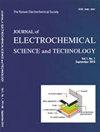Stabilizing Li2O-based Cathode/Electrolyte Interfaces through Succinonitrile Addition
IF 3
4区 工程技术
Q3 ELECTROCHEMISTRY
Journal of electrochemical science and technology
Pub Date : 2023-04-28
DOI:10.33961/jecst.2023.00087
引用次数: 0
Abstract
Li 2 O-based cathodes utilizing oxide–peroxide conversion are innovative next-generation cathodes that have the potential to surpass the capacity of current commercial cathodes. However, these cathodes are exposed to severe cathode–electrolyte side reactions owing to the formation of highly reactive superoxides (O x-, 1 ≤ x < 2) from O 2-ions in the Li 2 O structure during charging. Succinonitrile (SN) has been used as a stabilizer at the cathode/electrolyte interface to mitigate cathode–electrolyte side reactions. SN forms a protective layer through decomposition during cycling, potentially reducing unwanted side reactions at the interface. In this study, a composite of Li 2 O and Ni-embedded reduced graphene oxide (LNGO) was used as the Li 2 O-based cathode. The addition of SN effectively thinned the interfacial layer formed during cycling. The presence of a N-derived layer resulting from the decomposition of SN was observed after cycling, potentially suppressing the formation of undesirable reaction products and the growth of the interfacial layer. The cell with the SN additive exhibited an enhanced electrochemical performance, including increased usable capacity and improved cyclic performance. The results confirm that incorporating the SN additive effectively stabilizes the cathode–electrolyte interface in Li 2 O-based cathodes.丁腈加成稳定Li2O基阴极/电解质界面
本文章由计算机程序翻译,如有差异,请以英文原文为准。
求助全文
约1分钟内获得全文
求助全文
来源期刊

Journal of electrochemical science and technology
ELECTROCHEMISTRY-
CiteScore
6.30
自引率
8.10%
发文量
44
期刊介绍:
Covering fields:
- Batteries and Energy Storage
- Biological Electrochemistry
- Corrosion Science and Technology
- Electroanalytical Chemistry and Sensor Technology
- Electrocatalysis
- Electrochemical Capacitors & Supercapcitors
- Electrochemical Engineering
- Electrodeposition and Surface Treatment
- Environmental Science and Technology
- Fuel Cells
- Material Electrochemistry
- Molecular Electrochemistry and Organic Electrochemistry
- Physical Electrochemistry
- Solar Energy Conversion and Photoelectrochemistry
 求助内容:
求助内容: 应助结果提醒方式:
应助结果提醒方式:


